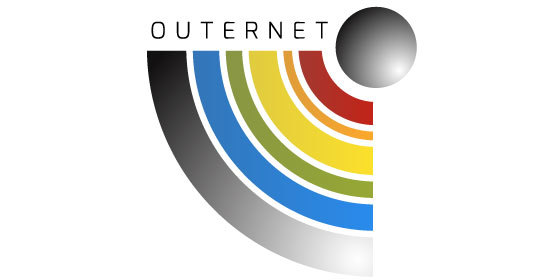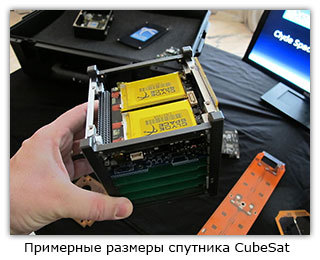A little more about the project «Outernet»

Just
Creation Goals
Only 60% of the world's population has access to the Internet. There are many hard-to-reach regions on the surface of the planet where it is very difficult to install a cellular tower or lay a data cable. In some regions, access to information is hampered due to additional restrictions. At the same time, now the number of devices with a WiFi-module exceeds the population of the Earth. Smartphones and tablet computers are getting cheaper, more and more people are becoming available - regardless of their geographic location. If you build a global wireless WiFi-network, then each owner of the device with WiFi support will be able to freely use the information. The main goal that the creators of Outernet want to achieve is to give the entire population of the Earth free and free access to information from the Internet - articles, news, educational materials, and more.
In the early stages of the launch, there will only be the possibility of transmitting data to the surface of the Earth, but the plans of the network developers include the organization of a two-way channel. In this case, a full Internet will be available from anywhere in the world. And, most importantly, free.
')
How everything will be organized
 The Outernet network is several hundred CubeSat satellites located in low earth orbit (193–220 kilometers above sea level). Each satellite receives data from a ground station and transmits it to the surface with a multicast protocol over UDP using WiFi technology.
The Outernet network is several hundred CubeSat satellites located in low earth orbit (193–220 kilometers above sea level). Each satellite receives data from a ground station and transmits it to the surface with a multicast protocol over UDP using WiFi technology.The production and launch of one satellite according to the CubeSat specification (according to different data ) costs approximately 50–100 thousand US dollars. As seen in the photo, the satellite has very small dimensions. According to the specification, the length of the ribs - 10 centimeters, weight - around 1.3 kilograms.
The satellite launched into orbit, having received certain data from the ground station, begins to loop them until it receives new data. At the same time they are broadcast by multicast via UDP protocol (multicast - when the recipient's address is not one, but not all addresses at once, but only a certain group of addresses) using WiFi. Although this technology is not very common, it has already been tested. For example, the Cisco StadiumVision Mobile platform allows you to use the stadium's WiFi network to stream content to all fans devices connected to it. This platform is implemented in sports arenas such as: Barclays Center (New York), Santiago Bernabeu (Madrid) and Sporting Park (Kansas City). More information can be found in the press release.
 Cisco.
Cisco.Further, the inhabitants of the Earth (cool sounds) can vote for what content should be broadcast, determining the priority list of information. As it is written on the official website of the project, it will be possible to influence priorities using SMS or special applications for mobile devices. Also, users will be able to offer to broadcast their own content by sending a request from the official site.
It is planned that Outernet will broadcast international and local news, pricing information, Bitcoin block chains, British Council English courses, other educational information and courses, software, music, video, the entire Wikipedia, and so on. Also, in Outernet channels will be available for emergency communication with rescue services, to coordinate the efforts of rescue teams, a global warning system will work. All this indicates that two-way communication (and not just broadcast) is quite feasible. A full-fledged two-way channel for working with the Internet within the framework of Outernet will not be available yet, but it is in the plans.
Startup stages of Outernet
- December 2013. Technical evaluation;
- June 2014. Launch of the first prototype satellites and testing of “long-range” multicast Wi-Fi;
- September 2014. Testing the quality of the broadcast from space (negotiations are underway to place test equipment on the International Space Station);
- January 2015. Launching into orbit and testing work in the group mode of several satellites;
- April 2015. Organization of the process of the continuous production of satellites;
- June 2015. Startup, configuration, commissioning of the Outernet network.
About the creators and developers of the network
The idea of creating Outernet was born within the walls of the Media Development Investment Fund.
 (Media Development Investment Fund, MDIF), which was created to finance independent media in those countries where there was a situation with their suppression. The Foundation works with newspapers, radio stations and television companies in Africa, Asia, Latin America, the CIS and the Balkans.
(Media Development Investment Fund, MDIF), which was created to finance independent media in those countries where there was a situation with their suppression. The Foundation works with newspapers, radio stations and television companies in Africa, Asia, Latin America, the CIS and the Balkans.The very idea of Outernet was proposed by Said Karim (Syed Karim) - director of innovation at MDIF. He is currently the leader of this project. Also involved in the creation of a network: Aaron Rogers (Aaron Rogers) from Q Space Systems, Branko Vukelik (Branko Vukelic) from Monwara Digital Products and Edward Birsen (Edward Birrane) from Tolerant Network Solutions. Well, and still inhabitants of the Earth who are ready to share their ideas and provide support.
Conclusion
Despite the fact that this is only a system for broadcasting data (such as radio or television), the fact that from any point on Earth and at no additional cost you can read any Wikipedia article, learn English, receive OpenStreetMap map data, or download the Ubuntu distribution - it pleases. I will look forward to news about the development of the project Outernet.
Source: https://habr.com/ru/post/212061/
All Articles